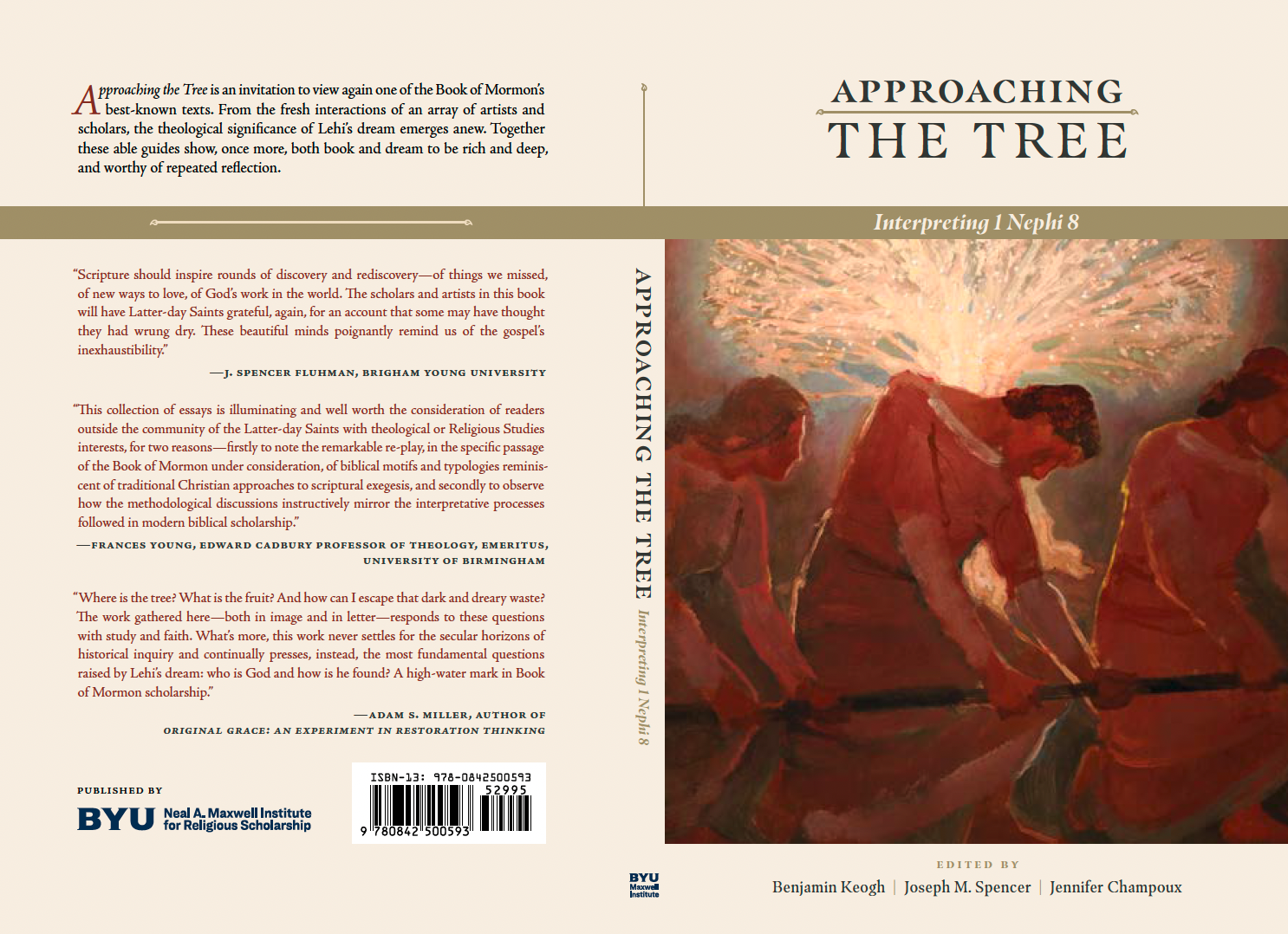 Review
Review
———
Title: Approaching the Tree: Interpreting 1 Nephi 8
Editors: Benjamin Keough, Joseph M. Spencer, Jennifer ChampouxPublisher: Neal A. Maxwell InstituteGenre: Religious Non-fictionYear Published: 2023Number of Pages: 288Format: PaperbackISBN: 978-0842500593
Price: $29.95
Reviewed by Conor Hilton for the Association of Mormon Letters
I finished Approaching the Tree: Interpreting 1 Nephi 8 less than a month ago, and I have already had the delightful occasion to playfully “well, actually…” a scriptural conversation with my in-laws. The careful close, readings, and striking insights packed throughout this short, densely packed, lovely book will stay with me, I hope, for years to come.
I am not aware of any book quite like Approaching the Tree, but I hope it serves as a model for engaging with scripture that many others follow. As the subtitle indicates, Approaching the Tree is committed to exploring and interpreting in word and in art, Lehi’s Dream, found in 1 Nephi 8 in the Book of Mormon. The book has three sections—some prefatory material, two scholarly overviews, and then a truly wondrous collection of essays alongside new works of art.
The first section sets up the project, noting that the presence of the art throughout the volume is intentional and “a gift that demonstrates art’s potency as a valid form of theological interpretation” (xii). This introduction, by editor Benjamin Keogh, also goes to great lengths to normalize and justify the book’s insistence on multiple, co-existing, sometimes contradictory, interpretations. Keogh says, “Some might worry that in gathering so many readings we needlessly (and perhaps confusingly) multiply interpretations. Some might, that is, object that a text cannot be made to mean just anything. Their objection would be correct. And yet, that a text cannot mean anything at all does not preclude it from meaning multiple things. Texts require interpretation, and in leaning into the variety of multiple interpretations we find a depth of meaning and real existential force” (xii). While personally already on board with texts having multiple co-existing, valid interpretations, I appreciated the thoroughness devoted here to justifying that choice within a theological framework.
The second section, “Visioning the Dream,” is an invaluable resource to scholars and anyone else who may be intrigued by a historical overview of scholarly interpretations of Lehi’s Dream (written by Joseph Spencer) or an overview of artistic interpretations of Lehi’s Dream (by Jennifer Champoux). These essays are packed with information, largely operating as informed literature reviews. Champoux works in her piece to also lay some groundwork for thinking about and engaging with art, particularly religious art, and maybe even especially art depicting or interpreting the Book of Mormon. Both provide countless nuggets and observations that could be followed up on and explored more thoroughly by other scholars and artists.
The third section is truly a delight! I will never be able to read Lehi’s Dream the same way again, both because of the eight new original works of art included here and the seven diverse and provocative essays. The art and the essays often speak to each other in powerful ways, with the pairings drawing even more attention to some of the themes being discussed. And sometimes there are additional insights derived from the contrast and slight repetition of the different interpretations working together. I was particularly struck by Annie Poon’s haunting artwork paired with Terryl Givens’ essay that suggests it might be more fruitful to read Lehi’s dream as a nightmare. I often found myself running with the insights and interpretations offered by the scholars and artists, drawing more connections than there was space to explore here—thinking specifically of Kimberly Matheson’s “The Tree of Knowledge and the Pedagogy of Lehi’s Dream,” where Matheson connects Lehi’s tree to the Edenic tree of knowledge of good and evil, thinking about how that insight may explain or give new weight to Lehi’s discourse about Eve and Adam and The Fall found in 2 Nephi 2.
This book is a treasure trove for folks studying and thinking about Lehi’s Dream. While the insights here are tied specifically to one single chapter of the Book of Mormon, the book as a whole models some fruitful approaches to scripture and should enliven scholarly, artistic, and personal engagement with the Book of Mormon.
Approaching the Tree: Interpreting 1 Nephi 8 is a lovely and powerful testament to the rewards waiting for those who closely read Restoration scripture. All disciple-scholar-artists of the Restoration would be well served to pick up a copy and spend some time in its pages. I hope to continue pondering the insights this beautiful dense volume contains and to see many more books modeled on its structure!
